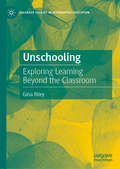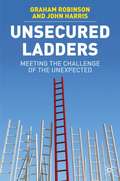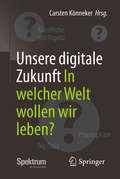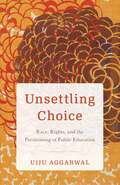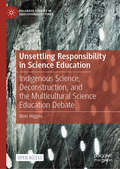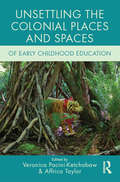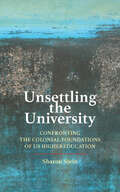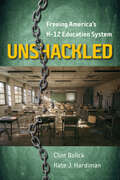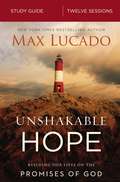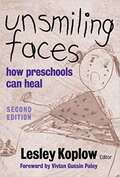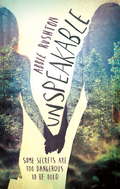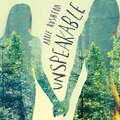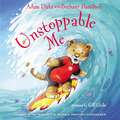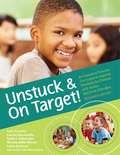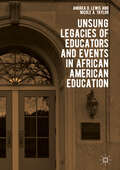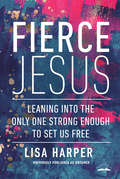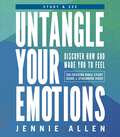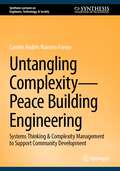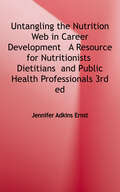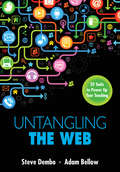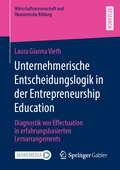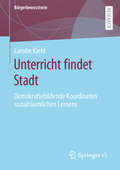- Table View
- List View
Unschooling Racism: Critical Theories, Approaches and Testimonials on Anti Racist Education (SpringerBriefs in Education)
by Pierre W. OrelusThis book draws on critical race theories and teachers’ testimonials grounded in 20 years of teaching experiences to reveal the ways in which racial and cultural biases are embedded in school curricula, and both their intended and unintended consequences on the learning and well being of students of color. More specifically, this book examines how these biases have played a significant role in the mis-education, misrepresentation, and marginalization of African American, Native American, Latino and Asian students. But the analysis doesn’t stop there. The author goes beyond the school walls to underscore how systemic racism, paired with colonialism, has impacted the lives of racially marginalized groups in both the United States and developing countries. This book uncovers these injustices and proposes alternative ways in which racism can be unschooled.
Unschooling: Exploring Learning Beyond the Classroom (Palgrave Studies in Alternative Education)
by Gina RileyThis book explores the history of the unschooling movement and the forces shaping the trajectory of the movement in current times. As an increasing number of families choose to unschool, it becomes important to further study this philosophical and educational movement. It is also essential to ascribe theory to the movement, to gain greater understanding of its workings as well as to increase the legitimacy of unschooling itself. In this book, Riley provides a useful overview of the unschooling movement, grounding her study in the choices and challenges facing families as they consider different paths towards educating their children outside of traditional school systems.
Unsecured Ladders
by Graham RobinsonThe book addresses the vital issue of how business leaders can prepare themselves to deal with the impact of unexpected events. It raises key questions for leaders to address if they are to avoid being distracted by crisis and remain in touch with a wider context that is subject to constant uncertainty and change.
Unsere digitale Zukunft
by Carsten KönnekerDroht die ferngesteuerte Gesellschaft?Dieses Buch greift das weithin diskutierte, zum Jahreswechsel 2015/16 veröffentlichte „Digital-Manifest“ auf und führt die Debatte entlang vielfältiger Themenlinien weiter. Es geht hierbei um nicht weniger als unsere – digitale – Zukunft: Welche Chancen eröffnen künstliche Intelligenz und digitale Technologien, welche Risiken und ethische Herausforderungen bergen sie? Wie schützen wir unsere Daten und die Privatsphäre? Wie sichern wir individuelle Freiheit und Demokratie vor Gefahren der digitalen Verhaltenssteuerung? Wie sollen selbstfahrende Autos, Roboter und autonome Agenten unser Leben prägen? Als Gesellschaft und als Individuen müssen wir uns mit verschiedenen Projektionen in die Zukunft auseinandersetzen. Dabei sollten wir die Einschätzungen führender Experten in der Zusammenschau vernehmen und diskutieren. Den kritischen Dialog zu beflügeln, ist das Ziel dieses Sammelbands mit den wichtigsten Beiträgen namhafter Wissenschaftler aus Spektrum der Wissenschaft, Spektrum – Die Woche und Spektrum.de.
Unsettling Choice: Race, Rights, and the Partitioning of Public Education
by Ujju AggarwalHow the Great Recession revealed a system of school choice built on crisis, precarity, and exclusion What do universal rights to public goods like education mean when codified as individual, private choices? Is the &“problem&” of school choice actually not about better choices for all but, rather, about the competition and exclusion that choice engenders—guaranteeing a system of winners and losers? Unsettling Choice addresses such questions through a compelling ethnography that illuminates how one path of neoliberal restructuring in the United States emerged in tandem with, and in response to, the Civil Rights movement. Drawing on ethnographic research in one New York City school district, Unsettling Choice traces the contestations that surfaced when, in the wake of the 2007–2009 Great Recession, public schools navigated austerity by expanding choice-based programs. Ujju Aggarwal argues that this strategy, positioned as &“saving public schools,&” mobilized mechanisms rooted in market logics to recruit families with economic capital on their side, thereby solidifying a public sphere that increasingly resembled the private—where contingency was anticipated and rights for some were marked by intensified precarity for poor and working-class Black and Latinx families. As Unsettling Choice shows, these struggles over public schools—one of the last remaining universal public goods in the United States—were entrapped within neoliberal regimes that exceeded privatization and ensured exclusion even as they were couched in language of equity, diversity, care, and rights. And yet this richly detailed and engaging book also tracks an architecture of expansive rights, care, and belonging built among poor and working-class parents at a Head Start center, whose critique of choice helps us understand how we might struggle for—and reimagine—justice, and a public that remains to be won. Retail e-book files for this title are screen-reader friendly with images accompanied by short alt text and/or extended descriptions.
Unsettling Literacies: Directions for literacy research in precarious times (Cultural Studies and Transdisciplinarity in Education #15)
by Jennifer Rowsell Chris Bailey Cathy Burnett Claire LeeThis book asks researchers what uncertainty means for literacy research, and for how literacy plays through uncertain lives. While the book is not focused only on COVID-19, it is significant that it was written in 2020-2021, when our authors’ and readers’ working and personal lives were thrown into disarray by stay-at-home orders. The book opens up new spaces for examining ways that literacy has come to matter in the world.Drawing on the reflections of international literacy researchers and important new voices, this book presents re-imagined methods and theoretical imperatives. These difficult times have surfaced new communicative practices and opened out spaces for exploration and activism, prompting re-examination of relationships between research, literacy and social justice. The book considers varied and consequential events to explore new ways to think and research literacy and to unsettle what we know and accept as fundamental to literacy research, opening ourselves up for change. It provides direction to the field of literacy studies as pressing global concerns are prompting literacy researchers to re-examine what and how they research in times of precarity.
Unsettling Responsibility in Science Education: Indigenous Science, Deconstruction, and the Multicultural Science Education Debate (Palgrave Studies in Educational Futures)
by Marc HigginsThis open access book engages with the response-ability of science education to Indigenous ways-of-living-with-Nature. Higgins deconstructs the ways in which the structures of science education—its concepts, categories, policies, and practices—contribute to the exclusion (or problematic inclusion) of Indigenous science while also shaping its ability respond. Herein, he undertakes an unsettling homework to address the ways in which settler colonial logics linger and lurk within sedimented and stratified knowledge-practices, turning the gaze back onto science education. This homework critically inhabits culture, theory, ontology, and history as they relate to the multicultural science education debate, a central curricular location that acts as both a potential entry point and problematic gatekeeping device, in order to (re)open the space of responsiveness towards Indigenous ways-of-knowing-in-being.
Unsettling the Colonial Places and Spaces of Early Childhood Education (Changing Images of Early Childhood)
by Veronica Pacini-Ketchabaw Affrica TaylorUnsettling the Colonial Places and Spaces of Early Childhood Education uncovers and interrogates some of the inherent colonialist tensions that are rarely acknowledged and often unwittingly rehearsed within contemporary early childhood education. Through building upon the prior postcolonial interventions of prominent early childhood scholars, Unsettling the Colonial Places and Spaces of Early Childhood Education reveals how early childhood education is implicated in the colonialist project of predominantly immigrant (post)colonial settler societies. By politicizing the silences around these specifically settler colonialist tensions, it seeks to further unsettle the innocence presumptions of early childhood education and to offer some decolonizing strategies for early childhood practitioners and scholars. Grounding their inquiries in early childhood education, the authors variously engage with postcolonial theory, place theory, feminist philosophy, the ecological humanities and indigenous onto-epistemologies.
Unsettling the University: Confronting the Colonial Foundations of US Higher Education (Critical University Studies)
by Sharon SteinShifts the narrative around the history of US higher education to examine its colonial past.Over the past several decades, higher education in the United States has been shaped by marketization and privatization. Efforts to critique these developments often rely on a contrast between a bleak present and a romanticized past. In Unsettling the University, Sharon Stein offers a different entry point—one informed by decolonial theories and practices—for addressing these issues.Stein describes the colonial violence underlying three of the most celebrated moments in US higher education history: the founding of the original colonial colleges, the creation of land-grant colleges and universities, and the post–World War II "Golden Age." Reconsidering these historical moments through a decolonial lens, Stein reveals how the central promises of higher education—the promises of continuous progress, a benevolent public good, and social mobility—are fundamentally based on racialized exploitation, expropriation, and ecological destruction.Unsettling the University invites readers to confront universities' historical and ongoing complicity in colonial violence; to reckon with how the past has shaped contemporary challenges at institutions of higher education; and to accept responsibility for redressing harm and repairing relationships in order to reimagine a future for higher education rooted in social and ecological accountability.
Unshackled: Freeing America’s K–12 Education System
by Clint Bolick Kate J. HardimanClint Bolick and Kate J. Hardiman begin with a thought experiment: how would we structure a 21st-century K–12 school system if we were starting from scratch, attending to contemporary parental needs and harnessing the power of technology? Maintaining that the status quo is unacceptable, they take a forward-thinking look at how choice, competition, deregulation, and decentralization can create disruptive innovation and reform education for all students.The US Supreme Court proclaimed 65 years ago in Brown v. Board of Education that our schools must provide equal educational opportunities, but as Bolick and Hardiman argue we have yet to make good on that promise. School systems are bound to antiquated structures, outdated technology, and bureaucratic systems that work for adults, not children. The COVID-19 pandemic has highlighted how ossified the traditional public school system has become. Today's ruptures in traditional learning create opportunity for reinvention. Unshackled explains that technology can redefine the ways students learn in and out of the classroom and highlights the benefits of expanding educational freedom so that families are able to choose an education that fits their child's needs.
Unshakable Hope Bible Study Guide: Building Our Lives on the Promises of God
by Max LucadoThis 12-session video Bible study will help you, your group, and your church stand on the definitive declarations of our mighty and loving God who governs the world according to his great and precious promises.This world has a tremble to it. There are things that seem unsteady in this life. But when we belong to God, it allows us to filter our problems through the promises of God. When we choose to be people of the promise, we choose to build our lives on the promises of God, not the circumstances of life.The stories of the men and women in Scripture were different, but the theme was the same: they were People of the Promise. Because of God&’s promises, Noah built an ark on dry land, Joshua claimed the Promised Land, David became king, Peter preached the first sermon, and John caught a glimpse of the future. Like them, we can also build our lives on God&’s promises, and trust him to keep them.This study guide includes tools for personal study and reflection, video notes, and questions for group discussion.Sessions include:You Are Stamped with God&’s ImageGod Will Win the VictoryYou Are an Heir of GodYour Prayers Have PowerGod Gives Grace to the HumbleGod Gets YouJesus Is Praying for YouDeath Has Been DefeatedJoy Is Coming SoonYou Will Have PowerThere Is No Condemnation in ChristJustice Will PrevailDesigned for use with the Unshakable Hope Video Study (9780310092117), sold separately.
Unsmiling Faces: How Preschools Can Heal
by Vivian Gussin Paley Lesley KoplowThe first edition of this indispensable book set the standard for high-quality intervention and prevention programs in early childhood practice. Since its publication, many new forces have impacted the landscape of early childhood education, presenting both great opportunities and great risks for today’s emotionally fragile young children. Once again making complex psychological concepts accessible to classroom teachers, this thorough revision: <p><p> Incorporates important understandings gained since the tragic events of 9/11. <p><p> Addresses many of the challenging issues that confront educators in the current high-pressure climate focused on academic performance. Includes recent scientific research that supports the concepts underlying high-quality intervention and prevention in early childhood practice—concepts that were the basis for the first edition of this book. <p><p> Provides an essential framework to help teachers understand the emotional lives of the young children they serve.
Unspeakable
by Abbie ToddMegan doesn't speak. She hasn't spoken in months.Pushing away the people she cares about is just a small price to pay. Because there are things locked inside Megan's head - things that are screaming to be heard - that she cannot, must not, let out.Then Jasmine starts at school: bubbly, beautiful, talkative Jasmine. And for reasons Megan can't quite understand, life starts to look a bit brighter.Megan would love to speak again, and it seems like Jasmine might be the answer. But if she finds her voice, will she lose everything else?
Unspeakable
by Abbie ToddMegan doesn't speak. She hasn't spoken in months.Pushing away the people she cares about is just a small price to pay. Because there are things locked inside Megan's head - things that are screaming to be heard - that she cannot, must not, let out.Then Jasmine starts at school: bubbly, beautiful, talkative Jasmine. And for reasons Megan can't quite understand, life starts to look a bit brighter.Megan would love to speak again, and it seems like Jasmine might be the answer. But if she finds her voice, will she lose everything else?
Unstoppable Me
by Adam DirksUnstoppable Me, written by New York Times bestselling author and champion surfer Bethany Hamilton with husband, Adam Dirks, tells the story of Makana the lion, who loves to surf but loses her nerve when she wipes out. When her friend encourages her to go back out again, Makana summons up the courage and discovers the success that comes from believing in yourself and never giving up.As seen in the feature film Bethany Hamilton: Unstoppable, this playful book will have little ones cheering for Makana and inspire them to stay strong and keep trying, no matter what challenges might come their way.
Unstuck and On Target!: An Executive Function Curriculum to Improve Flexibility for Children with Autism Spectrum Disorders
by Laura Anthony Lauren Kenworthy Lynn Cannon Katie C. Alexander Monica Adler Werner John Elder RobinsonFor students with autism disorders, problems with flexibility and goal-directed behaviour can be a major obstacle to success in school and in life. But flexibility and goal-setting can be taught just like any other skill, and this how-to-manual equips professionals with simple, real-world ways to help students with ASD develop this critical aspect of executive function. A classroom-based intervention approach for high-functioning students ages 8 - 11, this innovative guide gives special educators and other service providers ready-to-use lessons that promote cognitive and behavioural flexibility in everyday situations, from compromising with peers to handling schedule changes. Developed by a multidisciplinary team of reserachers and front-line professionals, the 27 lessons in Unstuck and On Target!: are tested and proven; reflect the learning style of students with ASD; target specific skills every student needs to learn more effectively and participate successfully in the classroom; free up teacher time; fit easily into any curriculum; and make learning fun. Ready for any professional to pick up and use, this complete guide gives users clear instruction, materials lists, and modifications for each lesson, plus invaluable Teacher Intervention Tips that help general educators reinforce the lessons throughout the school day.
Unsung Legacies of Educators and Events in African American Education
by Andrea D. Lewis Nicole A. TaylorThis book describes the contributions of twenty-two educators and events that have shaped the field of education, often receiving little to no public recognition, including: Edmonia Godelle Highgate, Nannie Helen Burroughs, Selena Sloan Butler, Alonzo Aristotle Crim, Sabbath Schools, and African American Boarding Schools. These individuals and events have established and sustained education in communities across the United States. This book will help foster a renewed sense of importance both for those considering teaching and for teachers in classrooms across the country.
Untamed: How the Wild Side of Jesus Frees Us to Live and Love with Abandon
by Lisa HarperToo many people settle for relating to Jesus merely as a comfortable friend and companion, when what we all need is an untamed Savior, a fearless champion tough enough to conquer our shame and compelling enough for us to follow Him without hesitation.
Untangle Your Emotions Bible Study Guide plus Streaming Video: Discover How God Made You to Feel
by Jennie AllenYour emotions are a gift from God.Most of us have been taught some damaging lessons about our emotions. Does the Bible really tell us that our emotions are untrustworthy? Were we meant to control and suppress our deepest feelings? Learn what it means to live an emotionally healthy life with Jennie Allen as she guides you through your own tangled up emotions and helps you discover how they actually help you notice what's wrong and connect with God and others more deeply.This six-session video Bible study (video streaming code included) will equip you to:Identify the unhealthy ways you might be coping with emotions.Learn a biblical step-by-step method to help you process, notice, and name what you're feeling.Talk about what you feel so that you can have meaningful connection with God, with yourself, and with those God puts in your life. This study guide includes:Individual access to six streaming video sessionsPersonal study between sessionsLeader&’s GuideSessions and video run times:Introduction (17:30)Notice (17:00)Name (17:00)Feel (17:30)Share (17:00)Choose (17:00)Watch on any device!Streaming video access code included. Access code subject to expiration after 12/31/2029. Code may be redeemed only by the recipient of this package. Code may not be transferred or sold separately from this package. Internet connection required. Void where prohibited, taxed, or restricted by law. Additional offer details inside.
Untangling Complexity—Peace Building Engineering: Systems Thinking & Complexity Management to Support Community Development (Synthesis Lectures on Engineers, Technology, & Society #29)
by Camilo Andrés Navarro ForeroThis book examines how the rapid acceleration and interconnection of globalization comes with the need for more flexible and adaptable solutions to complex problems and solutions. It describes and demonstrates possible combinations of methods and methodologies to address the complex problems that the world offers us today. Sharing meaningful experiences of the application of workshops in mixed public private companies and with vulnerable communities and peacebuilding communities. The text offers readers, who are looking for tools to face complexity and enhance their projects, real-world examples and accessible methods. The book is based on advanced engineering tools however it is understandable and accessible to a broad audience.This book is for decision makers involved with social complex systems who are uncertain about how they should start and proceed. Discussions on new methodologies to support engineering interventions with communities are being shown. A new multi-methodology proposal called “Complexity Funnel Methodology” (CFM) dissected in “Social Transformation Workshops” (STW) is provided and discussed. It is used with combinations of different methods and methodologies of critical Systems thinking. The implementation of this methodology is described using a case study approach.
Untangling Data-Based Decision Making: A Problem-Solving Model to Enhance MTSS
by Adam Collins Jason E. Harlacher Jon PotterThis book offers knowledge, strategies, and tools that will help you use data effectively. Applicable to any content area, the four simple steps in this book’s problem-solving model include specific questions that will guide your use of data to identify and solve problems that stand in the way of student achievement. Learn how to change instruction, curriculum, and environment to better support students.
Untangling the Nutrition Web in Career Development: A Resource for Nutritionists, Dietitians, and Public Health Professionals
by Jennifer Adkins Ernst"This book helps you untangle the web of career development in the fields of nutrition and public health by leading you through an important process of discovery; Understanding Yourself, Understanding Your Options, and Making Informed Choices. I have provided worksheets in each section for you to record your thoughts. In addition to looking at your own reservoir of experience, an essential part of the process requires research, so that you can answer the questions posed in this book. " --by the Author
Untangling the Web: 20 Tools to Power Up Your Teaching
by Stephen E. Dembo Adam S. BellowTwenty of the best web tools to enrich classroom experiences Few educators have time to find online learning resources that engage and allow students’ creative content expression while meeting core area standards. Discover 20 free tools—flexible enough for kindergarten through high school use—and learn how to leverage technology to transform your classroom. More than a “how-to” guide, you’ll receive access to a web site with videos for richer, in-depth exploration, an online community where you can connect and collaborate with educators, and advice, tips, tricks, and bite-sized anecdotes from ed tech leaders.
Unternehmerische Entscheidungslogik in der Entrepreneurship Education: Diagnostik von Effectuation in erfahrungsbasierten Lernarrangements (Wirtschaftswissenschaft und Ökonomische Bildung)
by Laura Gianna ViethDas unternehmerische Denken und Handeln nimmt eine immer bedeutendere Rolle in der ungewissen gesamtwirtschaftlichen Situation ein. Diese Aussage stützt sich auf die Verabschiedung der Europäischen Schlüsselkompetenzen, die zentral die unternehmerischen Kompetenzen hervorhebt. Da die Entrepreneurship Education von dem Grundsatz ausgeht, dass die unternehmerischen Kompetenzen erlernbar sind, liefert diese den Nährboden der vorliegenden Forschungsarbeit. Wissenschaftlich lässt sich über die Effectuation-Logik eine differenzierte Entscheidungslogik identifizieren, die es der Anwender*in ermöglicht, unter ungewissen Bedingungen erfolgreiche unternehmerische Entscheidungen zu treffen. Zur handlungsorientierten Anwendung der Effectuation-Logik bedarf es somit dem Effectuation-Kompetenzerwerb. Doch welche Rolle explizit die Effectuation-Kompetenzen bei dem Umgang mit der Ungewissheit haben, durch welches Lehr-Lernarrangement sie methodisch erworben und valide gemessen werden, ist noch ungeklärt. So wird über das empirische Forschungsvorhaben ein Instrument konstruiert, das die unternehmerische Entscheidungslogik anhand der Effectuation-Kompetenzen diagnostiziert und den Gütekriterien der Objektivität, Reliabilität und Validität entspricht.
Unterricht findet Stadt: Demokratiebildende Koordinaten sozialräumlichen Lernens (Bürgerbewusstsein)
by Carolin KiehlDas vorliegende Buch untersucht das Verhältnis zwischen demokratiebildendem Lernen und sozialräumlichen Spezifika im Kontext einer Gesellschaft der Vielfalt. Ausgehend vom Verständnis einer reflexiven, heterogenen und zu Teilen widersprüchlichen Gesellschaft werden fächerübergreifende Kompetenzen erhoben, welche als Facetten von Mündigkeit verstanden werden können. Dabei wird der Begriff des "Sozialraums" über das Quartierverständnis hinaus erweitert als relationaler Raum und figurativer Ausschnitt von Gesellschaft beschrieben. Im Bewusstsein einer lebensweltnahen Demokratiebildung entwickelt sich der Sozialraum dabei zum Koordinatensystem, aus welchem sich Gütekriterien, fördernde, aber auch hemmende Faktoren eines demokratiebildenden, sozialräumlichen Unterrichts ableiten lassen. Ausgehend von Prozessen der produktiven Realitätsverarbeitung und einer Theorie reflexiver Modernisierung wird Lernen als reflexiver und bewusster Vorgang im Verhältnis von innerer und äußerer Realität sowie im Kontext von Wissen und Nicht-Wissen untersucht. Die Analyse gibt Empfehlungen für verschiedene Fachdidaktiken, beschreibt sozialräumliches Lernen jedoch zugleich als reflektierenden Sozialisationsprozess, der zwar in Schule Verankerung findet, aber zugleich für ein lebenslanges Lernen außerhalb des schulischen Sozialraums spricht.

